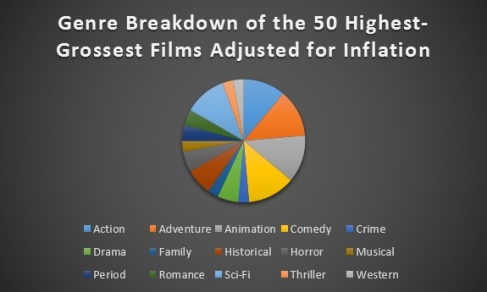I’m sad to disclose it, but it’s true. I’m quite worried that Hollywood is sexist, and if you were to sit down and watch the top fifty highest-grossing films (adjusted for inflation), I worry you’d think so too. Sure, there are love interests and the oh-so-cliche girl friend who always ends up with the lead’s best mate (Hermione and Lea, anyone?). Really though, how often do we find female leads in films nowadays anyway? Though more and more women are emerging as lead characters every year, we still have a long way to go.
First, let me hit you with the facts. Fifty films from a variety of decades, genres, and studios were compared to attain the data I’m about to reveal. Split into three categories (films with a male lead, films with a female lead, and films with an undetermined lead), films with a female lead and films with an undetermined came together in a tie for last place. Racking in only 6 films each, they each counted for 12% of the total films included in my study of the fifty highest-grossing films of all time. That’s a not-so-whopping 24% of the films compared which leaves… well, you know the math! After I took out all the movies with female leads and undetermined lead, 38 films remained– that’s 38 films with male leads. Unfair for female audiences? I’d say so, especially considering that 50% of the audiences in theaters across America are females!
In a similar study that was briefly discussed in an OverthinkingIt.com post, blogger Shana Mlawski studied a list posted on the Entertainment Weekly website about the 100 greatest characters of the last 20 years. Though the difference in the number of male and female actors appears to be more even-keeled in this list, it still places men in the lead. According to this list, roughly 67% of the favorite characters named were male while only 37% were female. That’s almost double the amount of male characters listed as there are female characters!
So why is it that males are often given the lead role over female characters? According to some literary circles, males are more relateable as heroes because of the sexist (but still present belief) that men are stronger–both mentally and physically–than women. Though recent literary and film series (such as The Hunger Games) have been starting to pop up and counteract this inaccurate portrayal of men being the only strong characters, it still may take some time before we see an evenly-balanced playing field for women among these lead roles.
Another trend that appears to be present in the film community is to give females more masculine qualities when they are presented with lead roles. Examples of this include Lara Croft in the Lara Croft series, the Scottish princess Merida in Pixar’s recent movie Brave, Rose in Titantic, Alice in the Resident Evil series and accompanying video games, Beatrix Kiddo in the Kill Bill series, and who could forget Scarlett O’Hara from Gone with the Wind? These are not meek women looking for a man to call all the shots. As a matter of fact, they’re quite the opposite. These women know what they want and aren’t afraid to go for it. They’re rule makers, rule breakers, and even with their feminine qualities they don’t walk on eggshells as passive characters.
For a great example of this type of strong female lead, check out the clip below from the movie Brave and keep your eye out for similar characters as your hit the theaters or watch re-runs this weekend.
In the end, I think what we can take away from this most is that while men are portrayed as lead characters in films much more often than women, there are always ways to cast female leads and create just as promising pictures. Is this more work? It could be, after all, you are having to overcome some pretty strong stereotypes in the process. That said, this is one of the areas of my research where I’m going to have to take an unlikely stance than one might have originally imagined from my patterns in prior topics. I do not think audiences want only male leads because they were twice as common in film. Rather, I think from looking at the female leads that were present, we can establish that audiences are happy with either gender as long as the lead is active, brave, and exhibits the heroic qualities that both sexes can portray.
Let me know what you think.
-The Plot Girl







